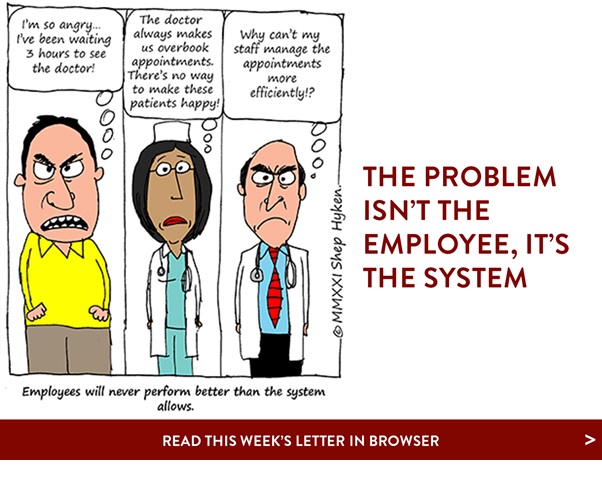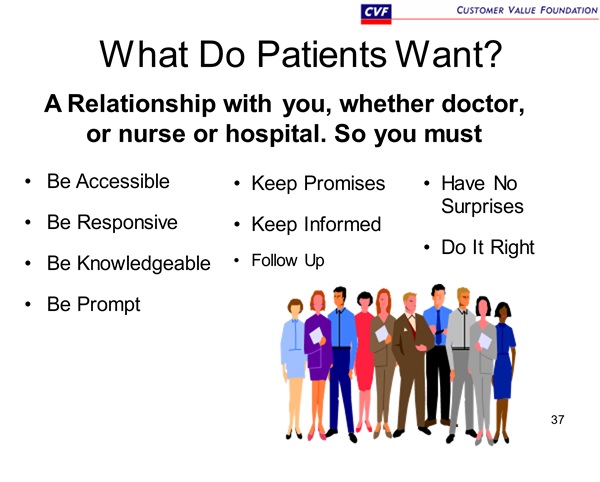By Gautam Mahajan and Edward R Pinto MD, FACC
This article is written jointly with a close friend, Dr Edward Pinto, who is a physician in the US.
Gautam spoke on the 28th January 2021 to software leaders and CEOs on Creating Value through Quality. Eddie (Edward Pinto) picked this up from YouTube https://tinyurl.com/y2vzjjya.
After listening to Gautam’s talk, Eddie called Gautam and bemoaned the fact that the US healthcare field was not focusing on customers. The health care services were mediocre, in spite of the US spending 16.9% of their GDP on healthcare. University medical schools which were rated in the top 10% of hospitals in the US in the seventies and eighties have much lower rankings today. They continue to have the best facilities and doctors, but have lost their focus on customers, and their healthcare services were middling.
If these hospitals were to treat the customer as a king their rating would improve. The customer is the patient!
No one in medicine has really thought of value creation in medicine except some of the top ranked hospitals like Mayo and Cleveland clinics. This is therefore an opportune time to write this article as we emerge from the Corona pandemic. Value creation is understood in business (though not entirely), but not talked about seriously in medicine where the business-oriented MBA administrators are king! And make the rules!!
Let’s start with a definition of creating value, as written in the Journal of Creating Value, jcv.sagepub.com :
Creating Value is executing normal, conscious, inspired, and even imaginative actions that increase the overall good and well-being, and the worth of and for ideas, goods, services, people or instructions including society, and all stakeholders (like employees, customers, partners, shareholders and society), and value waiting to happen.
So, in essence you have to improve the well being or do good for a patient. The worth of your medical service must be better and higher than others, so that patients feel they get more than they paid. Thus, in a business sense value is what you pay and what you get. It has a benefit component and a cost one. Cost includes effort, stress, anxiety, energy, psychic factors, self-image and time. So, pay attention to these. The problem is that feedback from the patient is rare when they are becoming well and is only available when their health is not improving!
Also, value waiting to happen is value you could create but do not notice it. Think of ways to improve value to patients, whether it means being nice to them, or listening to them, or avoiding unnecessary tests and surgery, or reducing wait time. Telemedicine is value waiting to happen in a big way.
In the US, we no longer have private practice; Corporate medicine has taken over, with a ‘complain and you lose your job’ mantra.
The first of many problems of the healthcare system, particularly in the USA is to figure out who the patient is. The healthcare provider, if it is a hospital has to consider administrators, doctors, patients, staff and nurses and of course the investor as customers. In doing this, the health care provider forgets who the real customer is. Without patients there would be no need for healthcare providers, no need for administrators or staff. Health care providers also must understand what customer value is. Customer value is not just the worth of the service (what you get and what you pay), but being superior to other providers. So, working on improving Customer Value is very important. And this means being a caring provider. Superior care and the patients feeling of valued care is a win-win for all. This is lacking in some medical centres.
Of course, the healthcare provider cannot forget other stakeholders such as the doctors, nurses and staff, and have to also create value for them. Value added stakeholders will create better value for patients.
Unfortunately, like education, medical care has become a business, to be run efficiently and with an eye to make money. MBAs are now administering hospitals, for improved profits. Gautam has always maintained that MBAs are not taught to create value for all stakeholders but to be good (?) administrators and efficiency experts. The MBA students have to understand that their role is to create value and they must be taught how to do so. This change of thinking has to come in healthcare management, where value creation is essential.
Remember, in the USA salary is tied to RVU’s or the number of patients seen in an hour and the dollars billed. This pressure is exerted by administrators, MBAs or doctor MBAs who have seldom seen a patient medically. They want doctors to see more and more patients and increase their billings to enrich the institution on the backs of providers of healthcare such as doctors, nurses and patients. Not a great situation for value creation in health care which is fast becoming an assembly line!! Shep Hyken in a recent article The Problem isn’t the Employee it’s the system says it all in this cartoon:

Caring of patients, making them feel wanted and cared for and important is key to success. Eddie recounted how he would call the 5 of many patients he had seen during the day at around 8pm. The five were the ones who seemed the most worried about their health. Eddie would call these anxious sick patients in the evening to check on their health. They appreciated the call and sometimes would give feedback to get Eddie to think of different and/or better treatment. Treat them well and they will be with you because they are happy…not just because they are being treated medically.
In the Journal of Creating Value, 3-1, Saradhi Motamarri wrote about Consumer Co-Creation in mHealth Service: The role of a patient is rapidly altering from a passive consumer to an active participant and integrator of multiple actors in his or her service network.
We ourselves have witnessed that when as a patient we feel assured, we feel comfortable, we feel cared for; we feel better, and less worried. The fact we can talk to our doctor makes us more assured. People talk about the psychological care of patients, taking care of his psyche.
As we reflect on what we need as patients, we want a caring doctor who has the time to discuss with us and explain what he is doing, a medical system where we are treated well, not just medically but as a human being.
Gautam remembers that he had a serious problem in San Francisco, and found the emergency care at the hospital wanting. He found a private practice doctor who was amazing in making Gautam feel comfortable and able to deal with his problem. He knew Gautam was visiting from India, and gave him a care kit free to carry back with him just in case he needed it. Gautam keeps remembering the doctor’s kindness and thinks of him as competent.
Most primary care physicians (PCP) know their customers, and have a good bedside manner. They will go out of their way to get their patient an appointment with a specialist or a room in the hospital. Most specialists tend to more brusque and even fewer take a holistic view of the patient as they focus basically on their specialised area. A good PCP takes a view on all the conditions and the anxiety of the patient, and the various medicines and how thy might interact with each other. Gautam’s mother-in-law acquired a new PCP at the age of 90. The first thing he did was to unprescribe a number of medicines various specialists had asked her to take. He said she was getting a cocktail of medicines many of which she did not need at this age. He left her with 2 or 3 medicines, and she improved.
In the USA and maybe now in India, often the PCP no longer follows the patient in the hospital but takes over upon discharge. This disjointed care makes the patient feel insecure and therefore some hand-holding and more explanation to sick hospitalized patients is important.
Unfortunately, this is sorely lacking even in the best hospitals. The university and major hospitals that have done this better are moving to the top in the rankings. Again, Value co-creation with the patient as No. 1.
It seems that best doctors are good in communication and even better listeners. These doctors are well organized, know the customer and are conscientious. They make customers feel they are cared for. Such doctors are aware (and curious). They embody Gautam’s 6As, awareness (curiosity), ability, attitude, anticipation, agility and ambidextrousness to create value. In the patient’s thinking. Eddie says it is 3As, availability, affability and ability in that order.
The principles of person-centred care are:
- Treat people with dignity, compassion, and respect.
- Provide coordinated care, support, and treatment.
- Offer personalised care, support, and treatment.
Value Based Health Care (VBHC) puts the patients, their families, doctors and their teams at focus. Patients with similar medical conditions have different preferences and they each follow roughly similar care-paths. Care quality improves by gauging the correct patient-relevant outcome measures. VBHC is an effort to develop and deploy products, services, and integrated solutions that improve patient outcomes per dollar spent in the healthcare system, measuring value in terms of long-term patient outcomes rather than short-term transactions.
Nurses operate on six core values which are commonly known as the 6 C’s. These are Care, Compassion, Competence, Communication, Courage and Commitment. Nurses who operate on these values ensure that the job gets done in an effective and efficient manner and that patients are safe and treated well. All those who work at a hospital or a clinic are responsible for value creation for the patient which translates into the kind of outcome and care given.
With an aging population, healthcare will have to focus on their needs more effectively. Separate facilities for geriatric and other vulnerable categories of patients become essential.
Here are things we think patients want

Let us learn to create value for patients, and for the other providers in the system, the administrators, doctors, the nurses, the support system, the staff, the investors. This comes back to the Business Roundtable, consisting of CEOs of the 3000 largest American companies, saying that the purpose of a company is to create value for all stakeholders. The medical system is slowly adjusting and changing to do this with new use of technology, telemedicine, virtual consultations and renewed focus on the customer.
The Corona pandemic has been a big strain on healthcare. Patients are also learning they can do with less handholding.
In India, the doctor and hospital visits have dwindled during this period of the pandemic. Is it because of fear of Covid, over doctorisation or what? It could also be more online consultation. Most doctors we know had a reduced practice to 30%.
Major medical centres are hurriedly appointing smart published researchers to head their departments in the hope of improving their rankings. Often these great researchers are poor candidates to enhance patient care and customer value creation. Parallel appointments of good clinically smart doctors who will enhance the delivery of customer value care is a must!
Value Creating healthcare facilities must become the dream, a dream which is achievable. These will be a boon/gift for all in healthcare. The customer in healthcare, the patient must come first.
We would love your comments. Gautam Mahajan ([email protected]) and Edward Pinto, MD, FACC ([email protected])



